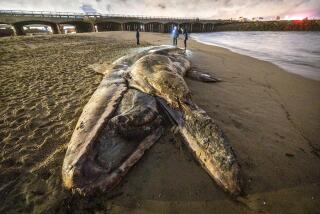In the Santa Barbara Channel, an underwater sound system tries to keep whales and ships apart
The taut rope that was lowering an underwater listening station to the ocean’s floor collapsed on the tug boat’s deck with a slap, signaling to the crew on board that their mission was complete.
They had successfully deployed a sound system in the Santa Barbara Channel.

The device could capture whale calls as far as 30 miles away. Cables connected the listening station — about 600 feet below sea level — to a buoy floating on the surface, which would transmit audio frequencies by satellite to scientists on shore.

The effort in early August was the latest attempt to prevent ships from running into whales in the channel, where large commercial boats coming in and out of the ports of Los Angeles and Long Beach cross paths with the feeding grounds of endangered blue, fin and humpback whales.
The initiative, planned to fully launch in early 2020, is designed to alert captains to slow their ships down. The sound system is about two miles away from traffic lanes in the channel that thousands of cargo ships traverse every year.
“The Santa Barbara Channel is like a buffet for a lot of whales,” said Douglas McCauley, director of the Benioff Ocean Initiative at UC Santa Barbara, which is sponsoring the $1.5-million project. “That hotspot happens to be right on the marine highway, kind of like the offshore version of the 101 that connects Santa Barbara to the ports of L.A./Long Beach.”
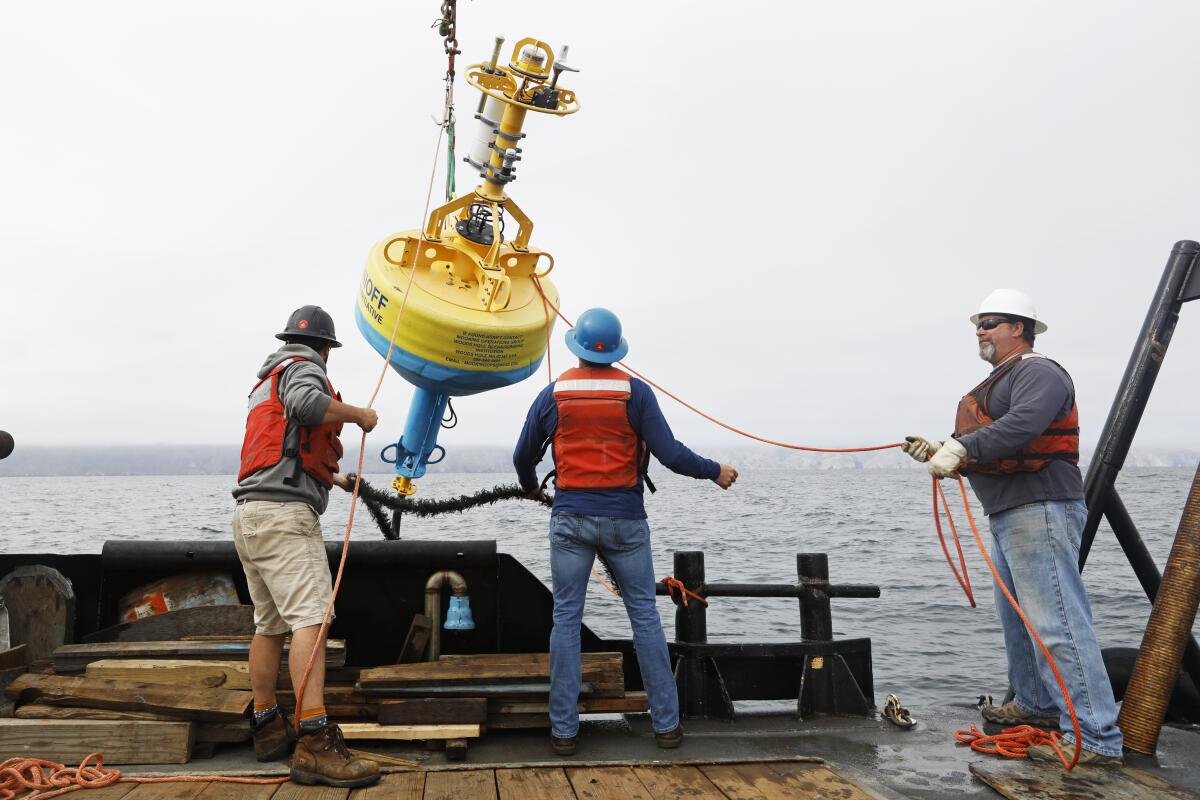
In 2007, five blue whales were found dead in the channel. Efforts to reduce deaths have included shifting the ship traffic lanes and offering financial incentives to companies that follow the National Oceanic and Atmospheric Administration’s request that ships slow down during whale season.
It hasn’t been enough. In 2018, 11 whales in California died in ship collisions, the highest number NOAA’s National Marine Fisheries Service has on record and a surge from the average 3.8 annual deaths over the previous five years. This year, at least 11 whales are known to have died.
The reality is likely far grimmer. Deaths often go unreported because whales typically sink when they die and are hit in remote areas. A 2017 study found that ship strikes kill more than 80 whales off the West Coast annually.
“If they’re not coming in wrapped around the bow of a container or cruise ship when they’re coming into a port, they go undocumented,” said Sean Hastings, the resource protection coordinator for NOAA’s Channel Islands National Marine Sanctuary.
Of special concern are blue whales, a population drastically reduced by commercial whaling. Most of the world’s more than 1,600 eastern North Pacific blue whales migrate up the West Coast every year from their winter habitat off Mexico and Central America, according to NOAA.

For Hastings, even several endangered whale deaths a year is unacceptable.
“Their populations are so suppressed that each animal counts in trying to rebuild those calculations,” he said.
Spotting whales from towering ships is difficult. Kip Louttit, executive director of the Marine Exchange of Southern California, a nonprofit that monitors ship traffic, said that a whale’s blowhole can be easily confused with the whitecaps of the sea.
And even if a watch officer sees a whale, the ship may not be able to turn fast enough to avert striking it.
“The watch officers are trying to figure out, is the whale going left, is the whale going right?” he said. “Let’s not have the ship avoid a whale and have a collision with another ship coming another way, or hit an oil platform.”
Scientists have also found that whales rarely react to oncoming ships. They have not evolved to respond to them as threats.
“It’s not like you can get struck by a couple ships and learn,” said John Calambokidis, a biologist at Cascadia Research in Olympia, Wash., who has researched this behavior.
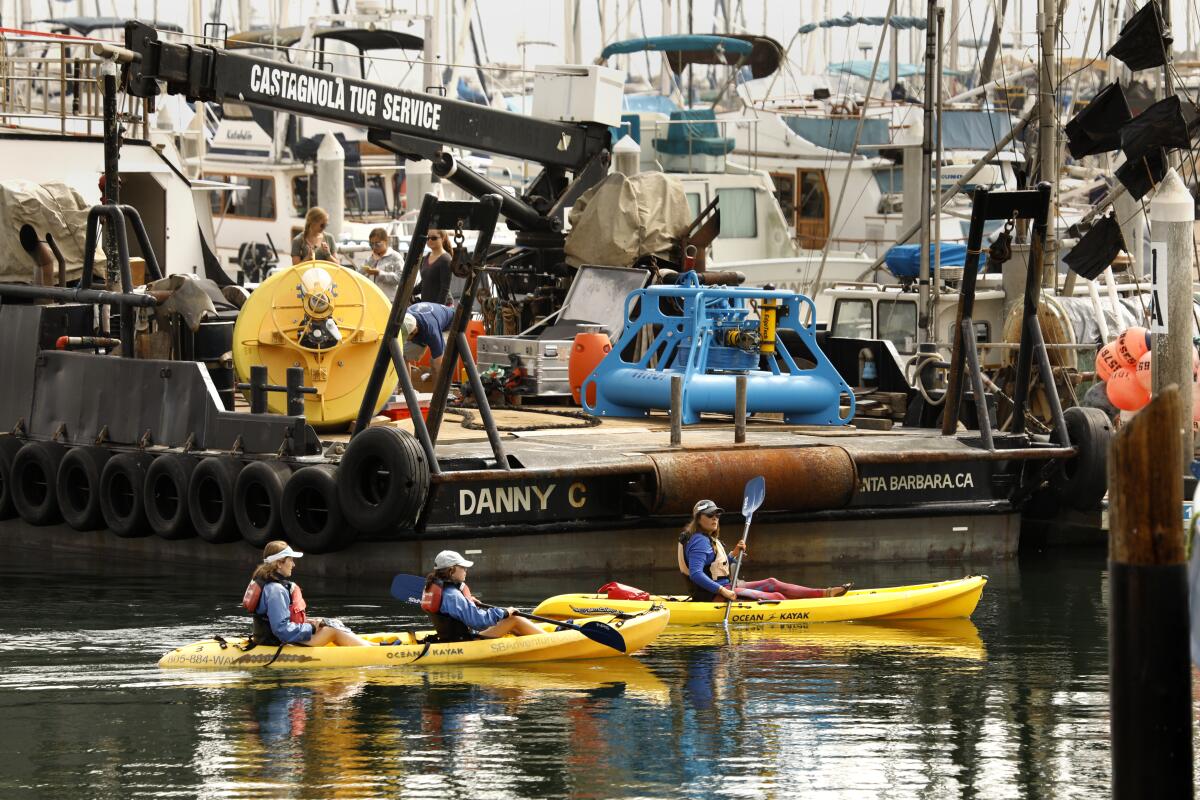
One solution has shown promise: slowing ships down. In 2008, NOAA required certain ships to travel at 10 knots (about 12 miles per hour) or less in areas along the East Coast to protect endangered North Atlantic right whales. One study found that the likelihood of whales being struck and killed by ships was reduced by 80% to 90%.
“Vessels going faster are much more likely to hit whales, and those whales that are hit are more likely to die when ships travel at faster speeds,” said Paul Conn, a co-author of the study and a statistician at NOAA’s Alaska Fisheries Science Center in Seattle.
But scientists on the West Coast say they’ve been disappointed by efforts to encourage ships to voluntarily slow down. Ships usually travel between 14 and 18 knots per hour along California’s shore. During whale season, which typically lasts from May to November, NOAA recommends that large ships travel no more than 10 knots in areas by the channel.
In 2018, about 20% of these ships in the channel slowed down, a rate that’s “not good enough,” according to Hastings.
He said that a program that offers financial incentives and positive publicity to companies that reduce their ships’ speeds shows a little more promise. It emerged from a partnership called Protecting Blue Whales and Blue Skies, which includes NOAA and several air pollution control districts. It aims to cut air emissions and to protect endangered whales in the channel and Bay Area.
It has grown from seven participating shipping companies in 2014 to 15 companies in 2019, according to Jessica Morten, a resource protection specialist who helps administer the program. Those 15 companies account for 90% of container ship traffic on the West Coast, but Morten said that she would like to see more of the participating companies meet the speed reduction criteria.
“I feel frustration and I know others on my team are a little disappointed that we’re not seeing higher levels of cooperation,” said Morten.
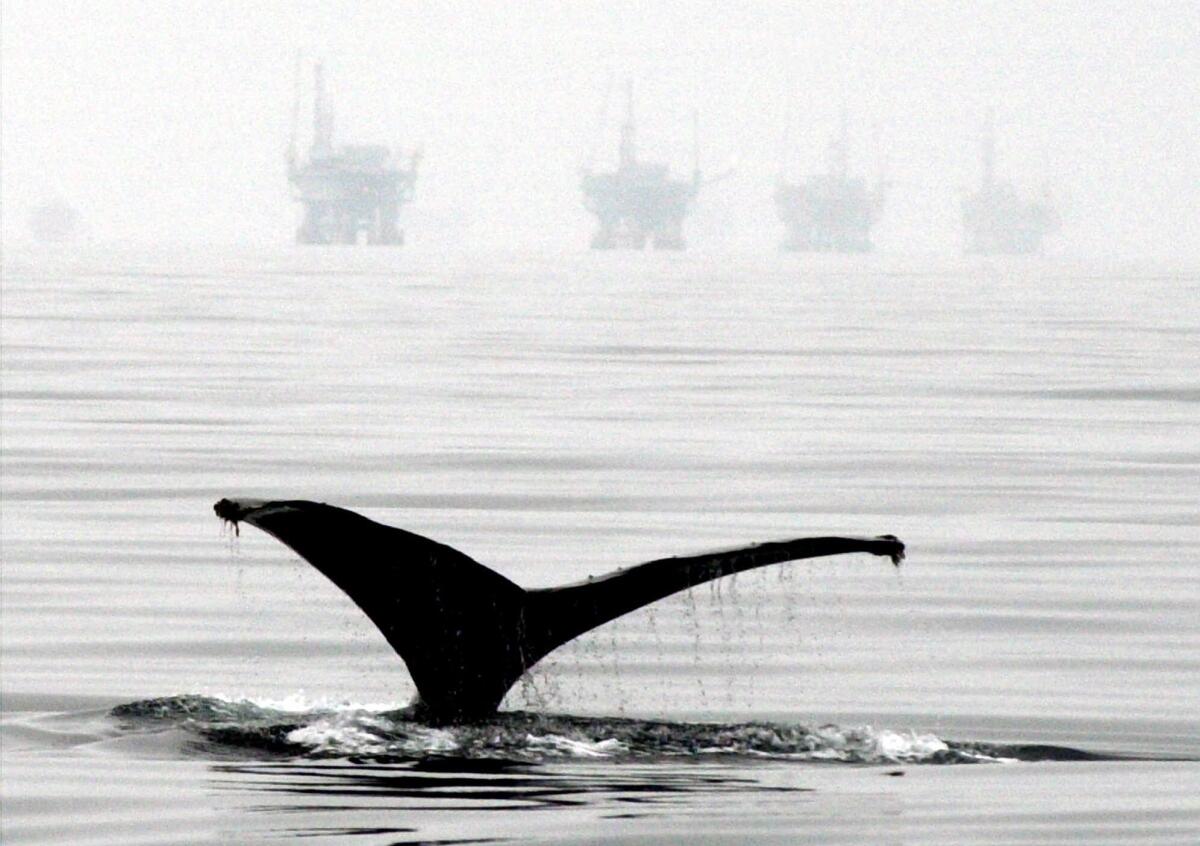
Scientists hope the new sound system will help better define when whale season starts and ends so that more shipping companies slow down.
But it has its limits, said Mark Baumgartner, a marine ecologist at the Woods Hole Oceanographic Institution in Massachusetts, who led the design of the system. The technology cannot pinpoint where whales are and can only tell scientists that whales have been heard in its coverage area.
“It’s telling you that they’re there and the risk of ship strike is elevated,” he said.
In addition, the project’s scientists have built a model that pairs historical data on where blue whales have traveled on the West Coast with data on current ocean conditions in order to predict where blue whales are likely to be.
It could predict that whales may show up earlier than usual during a year with anomalous warm water conditions, said Briana Abrahms, a research ecologist at NOAA designing the model.
The Benioff Ocean Initiative plans on providing direct updates to shipping companies on the level of risk to whales in the channel. The looming question, however, is whether this will encourage more companies to slow down.
John Berge, a vice president of the Pacific Merchant Shipping Assn., said ships might find it hard to be receptive to frequent updates.
“From a planning perspective, and so much of this is when and where you’re going to arrive at your next port of call, knowing something a few hours ahead might be difficult to incorporate,” he said.
But some companies have shown that they can commit to slowing down — at least, when they can build it into their schedules.
A trip between the ports of L.A. and Oakland typically takes up to 24 hours, but it’s about 30 hours at reduced speed, said Stanley Kwiaton, general manager of port operations for the West Coast for the Mediterranean Shipping Company, which has participated in the incentive program.
Kwiaton said ships might respond to updates on whale activity with the same flexibility they reserve for changes in the weather.
“More information is better than none,” he said. “If they provided us with something, at least the captain is going to assess it.”
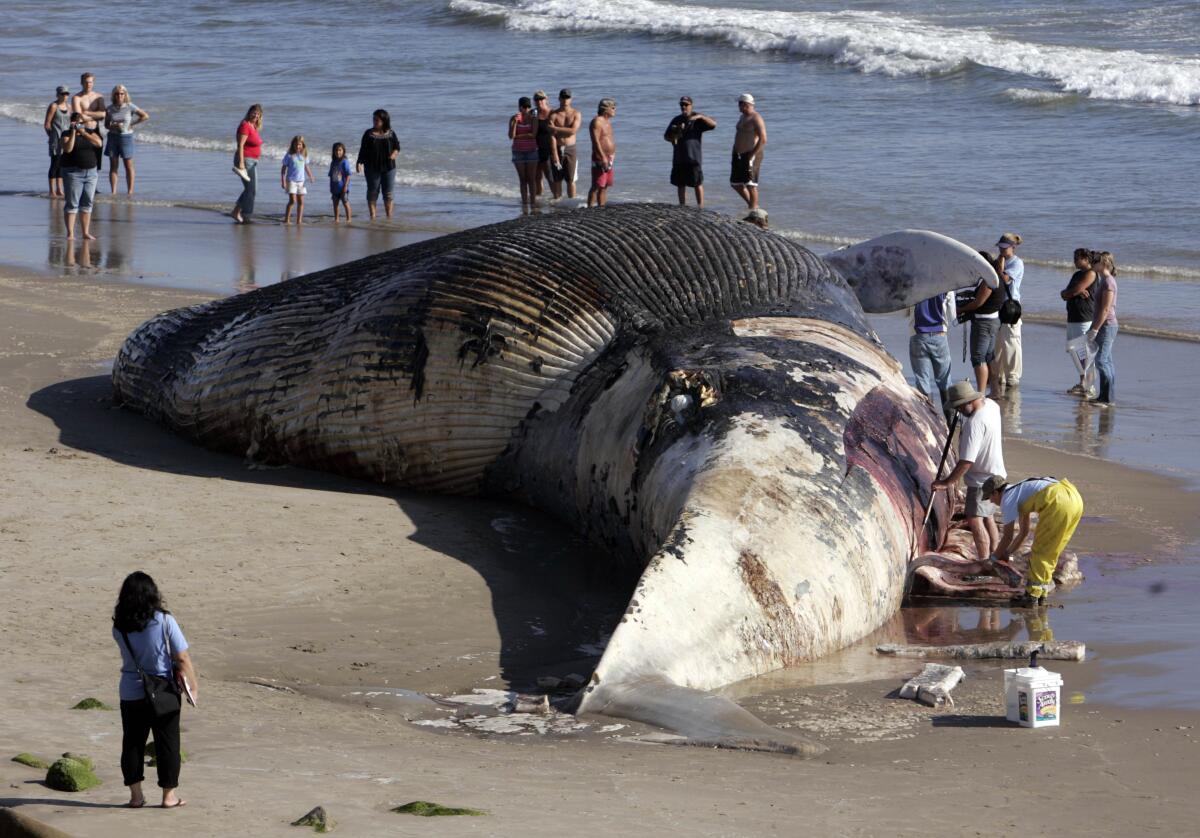
Hastings said that about 20% of traffic coming out of the ports of Long Beach and L.A. passes south of the Channel Islands and there has been some interest in diverting more traffic that direction. However, he said, complicating matters is the fact the Navy has a weapons-testing range in the area.
Other ideas include expanding an internationally recognized area that ships are to avoid around the islands. A study published last month found that expanding that area could reduce risk to whales.
Some experts, while appreciative of new approaches, are wary of continuing to invest in solutions that rely on ships voluntarily changing their behavior.
“I’m not sure if this will tip the scale to suddenly make industry much more responsive than it was,” Calambokidis said of the new sound system.
In 2007, the Center for Biological Diversity requested that NOAA create a mandatory 10-knot speed limit and later filed a lawsuit against the Coast Guard alleging its failure to ensure ship traffic doesn’t jeopardize endangered species.
“We definitely think that mandatory ship speeds are overdue,” said Catherine Kilduff, an attorney for the center.
Louttit said that as long as slowing down is voluntary, some companies will take the bad press that comes from arriving to port with a whale stuck to a ship’s bow. But he added that technology that provides a better sense of when whales are around is still useful.
“Just like driving your car, if you know there’s speed traps, you’re more likely to slow down than if there aren’t speed traps,” he said.
More to Read
Start your day right
Sign up for Essential California for news, features and recommendations from the L.A. Times and beyond in your inbox six days a week.
You may occasionally receive promotional content from the Los Angeles Times.


